06.06.2005
S. Klimov. Hardship of calculation-2
In the second part of the article the problem in question will be difficulties in selection of candidate moves that are related to a standard chess education of almost all professional chessplayers from candidate master and above. It is clear that education and patterns that it imposes have beside many advantages (which are overwhelming), some disadvantages as well. One easily misses the moves (and sometimes even plans!) that seem to contradict the rules learnt. Such neglects rarely result in blunders (in contrast to the difficulties that were described in the first part). Quite often it is just lost opportunities, underestimation of the resources of a "strangely" playing opponent, unnoticed strong idea.
There is a categorical appraisal in the head: "One must not play like this, just because one must not!" The opponent does it and ... wins. Stupidly located pieces at some instant begin to play better than your own. Or worse position gradually becomes lost, and this happens only because one had to exchange a strong bishop for a knight at the right moment and so on, and so forth. And finally one loses as many points as in case of direct blunders.
In other words, the matter concerns general strategic rules and exceptions from them, their types and ways to find them.
This domain submits considerably better to a rational analysis and training, and it is generally clearer than the topics discussed in the first part of the article. Indeed, if you have lost a game, because you missed a sideline move, you hardly should aim yourself at looking after all the sideline moves. The maximum that one can do is to ask somebody to select or to find by himself the examples to this theme. After all it is just a part of a general tactical vision, and probably it is more a question of the sporting form than of the tactical talent.
However, when a defeat is a result of superfluous respect to the fianchettoed bishop and unwillingness to exchange the c3-knight, there can be found examples in which one has to solve a problem of exchanging this bishop, to find reasons and cases when this exchange is profitable, thus the patterns that you have in your mind can be adjusted.
There are heroes in this area. They are not only geniuses and masters of small combinations, but they also know how to "play games" with their opponent, to choose the moves that the opponent does not take into account at all and to win in this situation. Their play is more various and less predictable, what is even more important, it puts more original questions to the opponent. Apart from an objective strength, this play also has a subjective, psychological influence on the opponent, who is gradually loosing orientation and ability to understand what happens on board.
Almost all the great players are more or less keen on it, when they play with weak opponents, nevertheless we can particularly emphasize some of them – Korchnoi, Ivanchuk, Morozevich.
Lindberg (2392) – Ivanchuk (2704) C11
Malmoe 2003
1.e4 e6 2.d4 d5 3.¤c3 ¤f6 4.Ґg5 dxe4 5.¤xe4 Ґe7 6.Ґxf6 gxf6 7.¤f3 a6 8.c4 0–0 9.Јd2

9...ўh8!? 10.0–0–0 ¦g8!? 11.Јc2 (11.g3!?) 11...f5 12.¤g3 (12.¤c3) 12...Јf8!? 13.ўb1 ¤d7
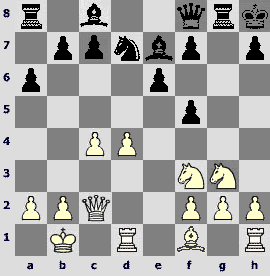
14.d5. After14.c5!? it was not easy for Black to prove benefits of the queen's location on g7.
14...¤c5 15.dxe6 (15.Јc3+!? Јg7 16.Јe3І Finkel) 15...fxe6 16.¤h5 Ґf6 17.Јe2 (17.¤xf6=) 17...b6 18.¤xf6 Јxf6 19.Јe5 Јg7 20.Јxg7+ ўxg7 21.¤e5 ¤e4 22.¤d3 ўf6і, and Black receives a small advantage in the endgame.
Wide strategic horizon and ability to see the exception-moves can be innate or developed. For example, when a grandmaster makes an analysis of the French Defense, he can come across a good, but quite rare idea that one can move the a-pawn on the queenside to a3 to seize the b4-square for his pieces. He can use it and achieve success, and then he will scrutinize it and try to apply it in other variation. If it works, the others will play like this and the move of the a-pawn will become a standard mean in several years. I am not quite sure in the authorship – as Alekhine wrote already in 1924, there always would be a fellow who would say about any novelty that he had already used that move in the coffeehouse game, but the above cited idea a7-a5-a4 seems to belong to Sergei Volkov).
The most basic patterns that are related, firstly, to an absolute strength of pieces, secondly, to their relative value, and thirdly, to standard maneuvers and pieces' positions, stay in the consciousness deeper than others. There is no sense to touch on the first point here; a material imbalance is a subject for a special talk.
Very often we come across the disturbance of the standards of relative value of the pieces, on which the advantage of experienced players is generally based. Indeed, the facts that a bishop is stronger than a knight in the open position, that an active piece is better than a passive one, that one does not have to exchange the attacking pieces, are well known, however, an automatism in the game understanding comes only with experience, and even not to every grandmaster. Until you do not have such experience, you only have to suffer at the board and to try to guess. And it is great, when you notice an exception move – often it just drops out of sight.
As an example we will cite a non-standard exchange of a bishop for a knight (or vice versa) that one makes in positions, when according to all rules one does not have to exchange, even must not because of weakening of the kingside (provided a fianchettoed bishop), in an open position and so on.
Kramnik (2772) – Van Wely (2700) D85
Wijk aan Zee 2001
1.d4 ¤f6 2.c4 g6 3.¤c3 d5 4.cxd5 ¤xd5 5.e4 ¤xc3 6.bxc3 Ґg7 7.¤f3 c5 8.Ґe3 Јa5 9.Јd2 ¤c6 10.¦c1 cxd4 11.cxd4 Јxd2+ 12.ўxd2 0–0 13.d5 ¦d8 14.ўe1 ¤a5 15.Ґg5 Ґd7 16.Ґd3 ¦dc8 17.ўe2 e6 18.Ґe3 exd5 19.exd5

19...b6. The easiest thing here is to play 19...b5 20.¤d2 (20.¦xc8+ ¦xc8 21.Ґxa7 ¤c4 22.Ґd4 ¦e8+ 23.ўd1 ¦a8 24.Ґxg7 ўxg7 25.Ґb1 ¤b6= Rychagov – Belov, St.Petersburg 2001) 20...a6 21.¤e4 ¤c4 22.Ґxc4 (22.¤c5 ¤xe3 23.fxe3 Ґg4+ 24.ўf2 Ґb2 25.¦c2 Ґa3 is good for Black) 22...bxc4 23.¤c5 (23.¤d6 ¦d8) 23...¦d8 24.¤xd7 ¦xd7 25.¦xc4 ¦xd5= Lautier – Svidler, Pojkovsky 2003.
20.Ґa6 ¦d8 21.¦hd1 Ґc8. An alternative is 21...Ґa4!? 22.¦d3 b5 (22...¦d7 23.¦a3 b5 24.¦c5 ¤b7 25.Ґxb7 ¦xb7 26.¦d3І) 23.Ґf4 (23.d6 ¤c4 24.d7 Ґb2 25.¦e1 Ґc2 26.¦d5 Ґe4 27.¦dd1 Ґc2 28.Ґg5І Ftacnik) 23...¤c4 24.Ґb7 Ґb2 25.Ґxa8 Ґxc1 26.Ґxc1 ¦xa8 – in the same 2001 year 2 games proceeded this way.
22.Ґxc8 ¦axc8 23.¦xc8 ¦xc8. At this moment the main events started and almost straight away finished!
24.¤d4! With the idea ¤b5 and d6. The fact that the knight is brought into play is important in order to support the pawn advance.

24...Ґf8? Loses almost by force.
24...¦c7 25.¤b5 ¦d7 26.¦c1! h6 27.d6± ... 27...a6 28.¦c7 ¦d8 29.Ґxb6 axb5 30.d7ќ;
24...a6 25.¤c6 a) 25...¤xc6 26.dxc6 ўf8 (26...Ґe5 27.f4 Ґc7 28.ўf3І) 27.¦c1 b5 28.Ґf4І; b) 25.d6 ¦d8 26.¤f5 (this variation is better than the one that considered by M.Krasenkow 26.¤e6 fxe6 27.Ґxb6 ¤b7 28.Ґxd8 ¤xd8›) 26...gxf5 27.Ґxb6. The difference from 26.¤e6 consists, firstly, in considerably greater weakness of the Black's kingside, and secondly, in the fact that White has the d5-square for the king or a rook. The position of Black is difficult: 27...¦e8+ (27...¤c6 28.Ґxd8 ¤xd8 29.¦d5 ўf8 (29...¤e6 30.¦a5 ўf8 31.ўd3 ўe8 32.ўc4 Ґd4 33.¦xf5±)) 28.ўf3 ¤c6 29.d7 ¦f8, and in addition to a banal regaining of a piece, after which Black still has to work to make a draw, White has an interesting 30.¦d6 ¤d8 31.ўf4.
One should have played 24...Ґxd4! (Vladimir Kramnik considers this move to be the only playable, however, only one of other annotators of this encounter (Ftacnik and Krasenkow) mentions it, and only with a short variation, where Black plays obviously weak! Is it the magic of the g7-bishop? ) 25.Ґxd4 (25.¦xd4 f6 26.ўd3 ўf7 27.g4 ¤b7 ... 28.¦a4 ¦c7 Kramnik) 25...f5 (Ftacnik considers only a suicidal 25...¦c2+ 26.ўd3 ¦xa2 27.d6ќ – Black removes the rook from the white passer).
25.¤b5! a6 26.d6! ¦c2+ (26...axb5 27.d7 ¦d8 28.Ґxb6 ¤c6 29.Ґxd8 ¤xd8 30.¦d5ќ, in view of threatening ¦e5 the b5-pawn is lost) 27.ўd3 ¦xa2 (27...¦c6 28.d7 Ґe7 29.¤c3 ¦d6+ 30.ўe2 ¦xd1 31.ўxd1 Ґd8 32.¤d5 ¤c4 33.Ґf4 ўf8 34.ўc2 – one cannot approach the pawn, the position of Black is pretty hard (Kramnik).)
28.d7 ¤b7 (28...¤c6 29.¤a7ќ; 28...Ґe7 29.¤c3 ¦a3 30.Ґxb6 ¤c6 31.ўc2 Ґf6 32.¤d5ќ) 29.¤c3 ¦b2 30.¤d5 ¦b5 31.ўc2 Ґc5 32.Ґh6 f6 33.¤c7. Black resigned. The comparative strength of the bishop and the knight turned out to be incommensurate, and after the missed exchange Black's play got derailed.
This is not the only case of "blindness". The exchange of the g7-bishop drops out of sight even of the strongest players.
Jimenez – Larsen
Palma de Mallorca 1967

Bent Larsen: "I am really proud of this move!"
14...Ґxe5! 15.dxe5 d4 16.Ґh6 ¦fd8 17.Ґxe6 fxe6 18.¦fe1 ¦d5 19.Ґf4 ¦f8 20.g3 ¦f5
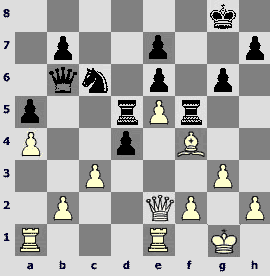
21.¦ad1. In reply to a better21.h4 Larsen gives another variation 21...d3 22.Јd2 Јd8 with a threat of ¤xe5 that is hard to repel. Although Fritz shows the defense 23.¦a3 … c4. I think, White can hold after this: 23...¤xe5 24.Ґxe5 ¦fxe5 25.¦xe5 ¦xe5 26.c4 ¦e2 (26...Јd4 27.¦xd3 Јxc4 28.b3і – here the advantage of Black is rather formal) 27.Јxd3 Јxd3 28.¦xd3 ¦xb2 29.¦d8+ ўf7 30.¦a8 b6 31.c5 bxc5 32.¦xa5 ¦c2 33.¦a8 e5 34.a5 ўe6 35.a6 ¦a2 36.a7=.
21...Јb3 22.h4 Јxa4 23.Јe4 Јb3 24.cxd4 Јxb2 25.¦b1 Јxd4 26.¦xb7 ¦dxe5 27.Јb1 ¦xe1+ 28.Јxe1 Јd5 29.Јc1 ¤d4 30.¦b8+ ¦f8 31.¦xf8+ ўxf8 32.Ґh6+ ўe8 33.Јc8+ Јd8 34.Јc4 ¤f5 35.Ґf4 ўf7 36.Ґe5 Јd1+ 37.ўh2 Јd2 38.Јc5 a4 39.Ґc3 Јc2 40.ўg1 Јd1+ 41.ўh2 Јd5 42.Јb4 Јf3 43.ўg1 a3 0–1
Kacheishvilli (2599) – Vallejo (2678) D80
Calvia (Olympiad) 2004
1.d4 ¤f6 2.c4 g6 3.¤c3 d5 4.Ґg5 ¤e4 5.Ґh4 ¤xc3 6.bxc3 dxc4 7.e3 Ґe6 8.Јb1 b6 9.¤h3 Ґh6
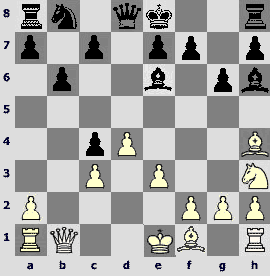
10.¤g5?! White moves on g5 with another piece, but the cruelty of punishment here seems to be extremely incommensurate to the blunder – White simply stands worse! 10.Ґg5 Ґxg5 11.¤xg5 Јd5 12.¤xe6 Јxe6 (Goldin – Kudrin, San Diego 2004).
10...Ґxg5 11.Ґxg5 Јd5 12.Ґh4 ¤c6 13.f3 (13.e4? Јa5 и ¤xd4) 13...Јa5 14.Јb2 0–0–0і. Black has both material and positional advantage.
15.Ґe2

15...g5! 16.Ґg3 f5! 17.0–0 ¦hg8 18.e4 f4 19.Ґf2 g4! 20.fxg4 (20.d5?! gxf3 21.Ґxf3 ¤e5 22.Ґd4 ¤d3) 20...Ґxg4 21.Ґxc4 Јh5!?
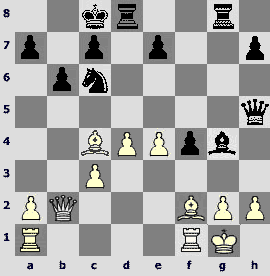
Since this moment I had already annotated this game in the second survey of the Olympiad, therefore, further I give no comments.
22.Ґxg8 ¦xg8 23.Јd2 Ґf3 24.Ґg3 fxg3 25.gxf3 Јh3! 26.Јe2 ¤d8 27.f4 ¤e6 28.Јd2? ¦g4! 29.¦ad1 ¤xf4 30.e5 gxh2+ 31.ўh1 ¤h5 32.¦f8+ ўb7 0–1
The standards of maneuvers and pieces locations both general and typical for a particular structure have quite great influence on the "screening" of candidate moves.
Let us give an example of several such standards.
A piece in the offside
Korchnoi (2630) – Hulak (2495) E99
Zagreb 1987
1.¤f3 ¤f6 2.c4 g6 3.¤c3 Ґg7 4.e4 0–0 5.Ґe2 d6 6.d4 e5 7.0–0 ¤c6 8.d5 ¤e7 9.¤e1 ¤d7 10.Ґe3 f5 11.f3 f4 12.Ґf2 g5 13.¤b5!?
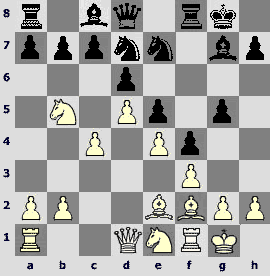
To make this move one, firstly, has to be ready to move the knight on a7 in reply to a7-a6 and get stuck on this square that fairly speaking is not pleasant. Secondly, if the opponent plays b7-b6, than one will be forced to waste time on the knight's retreat – so one loses time for a weakness of black queenside. Both are not trivial.
13...a6. It is better than 13...b6 14.b4 a6 – perhaps, White ceased to play in that way exactly because of this continuation. Here there are some examples from the experience of strong chessplayers:
15.¤c3 h5 16.ўh1 ¤f6 17.c5 g4 18.cxb6 cxb6 19.¦c1 g3 20.Ґg1 gxh2 21.Ґf2 h4 22.¤a4 ¦b8 23.b5 axb5 24.Ґxb5 ¤h5 25.ўxh2 ¤g3› Korchnoi – Ye Jianqchuan, Novi Sad 1990;
15.¤a3 15...h5 16.c5 b5 17.¤ac2 ¤f6 18.a4 bxa4 19.¦xa4 ¤g6 20.b5 g4 21.¤b4 g3 22.hxg3 fxg3 23.Ґxg3 h4 24.¤c6 Јd7 25.Ґh2 Ґh6 26.f4 ¤xf4 27.bxa6 Јg7„ Huzman – Smirin, Sverdlovsk 1987.
14.¤a7 ¦xa7. It is practically forced – Black should prevent the opponent from exchanging the c8-bishop: in the attack this piece is considerably more important than the notorious "Gufeld bishop".
15.Ґxa7 b6 16.b4 Ґb7 17.c5 dxc5

18.¦c1! ¤c8
18...cxb4 19.d6 (19.Јa4 a5 20.Ґb5 ¤f6 21.Јc2 Јa8 (21...¤c8 22.Ґb8ќ; 21...¤exd5 22.exd5 ¤xd5 23.Ґc4 ¦f7 24.¤d3 ¦d7 25.¦fe1ќ) 22.Јxc7 ¦c8 23.Јxe7 ¦xc1 24.Јe6+ ўh8 25.Јxb6± Korchnoi) 19...cxd6 (19...¤c6 20.Ґxa6 Ґxa6 21.¦xc6±) 20.Јxd6 ¦f6 (20...¤c8 21.Јc7 ¤c5 22.Ґxb6 ¤xb6 23.Јxc5±) 21.Јc7 Јc8 22.¤d3 ¦c6 23.¦xc6 ¤xc6 24.Јxc8+ Ґxc8 25.¦c1 ¤xa7 26.¦c7± Karolyi – Kupreichik, Lvov 1988.
19.bxc5 Ґa8 (19...¤xc5 20.¦xc5ќ) 20.c6 ¤f6 21.Ґxb6 ¤xb6 22.Ґxa6±. One nevertheless captures the bishop, however, what is on a8 is not a piece.
22...g4 23.¤d3 g3? deprives Black of a counterplay at all.
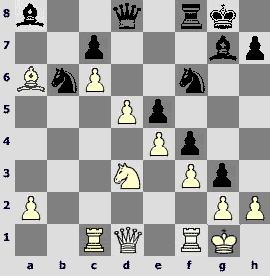
24.h3ќ ¤e8 25.¤c5 Јb8 26.a4 ¤d6 27.a5 ¤bc8 28.ўh1 Јa7 29.Јc2 ¤e7 30.¦b1 ¤g6 31.¦fc1 Ґf6 32.Ґf1 Ґxc6 33.dxc6 Јxa5 34.¦a1 Јb4 35.¤e6 1–0
Kramnik (2802) – Anand (2794) D27
Dortmund 2001
1.d4 d5 2.c4 dxc4 3.¤f3 e6 4.e3 ¤f6 5.Ґxc4 c5 6.0–0 a6 7.Ґb3 cxd4 8.exd4 ¤c6 9.¤c3 Ґe7 10.Ґg5 0–0 11.Јd2 ¤a5 12.Ґc2 b5 13.Јf4 ¦a7 14.¦ad1 Ґb7!?
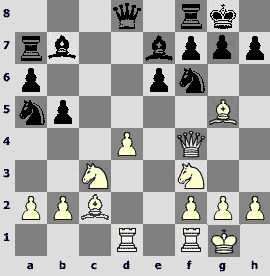
One can rarely see such location of the rook and the queen's bishop, especially since one could play 13...Ґb7 even at the previous move.
15.d5! Ґxd5 16.¤xd5 exd5 17.Јh4 h5! This move is absolutely non-standard (Fairly speaking, I never saw an unprotected pawn on h5 in a position with isolated pawn). In case of 17...h6 the h6-bishop sacrifice is winning and if one plays 17...g6, a winning reply is 18.¦fe1.
18.¦fe1 ¤c6
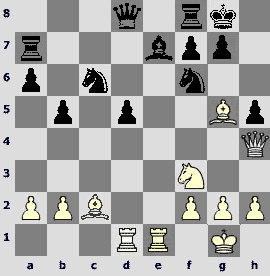
19.g4! Јd6 20.gxh5 Јb4 21.h6! Јxh4 22.¤xh4 ¤e4 23.hxg7 ¦c8 24.Ґxe7 ¤xe7 25.Ґxe4 dxe4 26.¦xe4±, and White has realized his material advantage. However, one must not put aside his ideas in spite of the dismal end for Black...
Weakening of pawns' structure
Krasenkow (2585) – Sakaev (2655) E12
Copenhagen 2003
1.d4 ¤f6 2.c4 e6 3.¤f3 b6 4.¤c3 Ґb7 5.a3 d5 6.cxd5 ¤xd5 7.Јc2 ¤xc3 8.bxc3 Ґe7 9.e4 0–0 10.Ґd3 c5 11.0–0 Јc8 12.Јe2 Ґa6 13.¦d1 Ґxd3 14.¦xd3 ¤d7 15.e5 Јc6. Perhaps, more accurate is 15...cxd4 16.cxd4 Јc4 (one pins the rook on d3 straight away) 17.Ґg5 Ґd8!? 18.¦ad1 Јd5 19.h4 f6 20.exf6 Ґxf6 21.¦e3 h6 22.Ґf4 ¦ae8 23.Ґg3 ¦f7 24.a4 ¦fe7 25.Јc2 Јf5 26.Јb3 Јd5 27.Јc2 Јf5 28.Јc6 Јd5 – it is a draw (Radjabov – Leko, Dortmund 2003).
16.Ґg5 ¦ae8. In the game Radjabov – Anand (Linares 2003), where White had used the move 15.e5 for the first time, the following was 16...¦fe8 17.Ґxe7 ¦xe7 18.¤g5 cxd4 19.cxd4 f6 20.exf6 ¤xf6 21.¦e1 h6 22.¤f3 ¦c8 23.¤e5 Јc2 24.Јf3 ¤d5 25.Јg3 – and players agreed to a draw. Sakaev wants to keep the second rook on f8 in view of f7-f6.
17.¦ad1
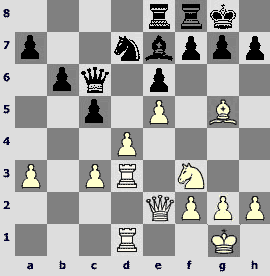
17...f6. It is most likely that White wants to make an exchange on e7 at some instant, and to move the knight on g5 … ¤e4-d6 or attack on e7. In the encounter in question Sakaev, like Anand, makes quite a crucial decision – he deals with both problems by means of the move f7-f6, though we should notice that he organizes himself "perpetual" weaknesses along the e-file. This decision did not work out; therefore, it is reasonable to pay more attention to a careful 17...h6, after which White has a choice – to exchange the bishops, as one planned beforehand, or to move the bishop backwards trying to use the weakening of king's position: 18.Ґxe7 (18.Ґc1!? ¦d8 (18...b5 19.dxc5 ¤xc5 20.¤d4 Јb6 21.¦g3ќ) 19.c4 cxd4 20.¤xd4 Јxc4 21.Ґxh6 ¤xe5 22.Јxe5 Ґf6 23.Јe3 ¦d5„) 18...¦xe7. Poor is 19.¤d2 with an idea to move the knight on d6 using the other route. Black can play 19...cxd4 20.cxd4 Јc2, and in response to 21.Јf3 (otherwise it is not clear how to deal with the pin) 21...f6 with a variation that is more profitable for Black than the one in the game.
18.exf6 Ґxf6 19.Ґxf6 ¤xf6 20.¤e5 Јc7
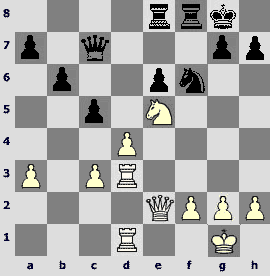
21.c4! White has no more weaknesses than in case of a simple exchange of pawns c:d4 c:d4, however, a control over the d-file is considerably important.
21...cxd4. This cedes the d-file. Nevertheless, the following variation does not help: 21...¦d8 22.dxc5 (22.d5 ¦d6!І (22...exd5 23.cxd5 c4 (23...¦fe8 24.d6±) 24.d6 Јc5 (24...cxd3?? 25.Јa2+ќ) 25.¦d4 b5 26.d7 c3)) 22...bxc5 (22...¦xd3 23.¤xd3 – it will be pretty hard to make a draw without an extra pawn), and here 23.g4!? (by sample of the game) deserves attention e.g.: 23...¦xd3 24.¦xd3 Јb7 25.g5 ¤e4 (25...Јe4 26.¦e3 Јb1+ 27.Јf1 Јxf1+ 28.ўxf1 ¤h5 29.¤d7±) 26.Јg4ќ.
22.¦xd4 ¦d8 23.Јe3! ¦xd4 24.Јxd4 ¦c8. To prevent the situation that had happened in the game, one may play 24...Јe7!?, for example: 25.Јd6 (25.¦d3!?; 25.g4 Јxa3 26.g5 ¤h5) 25...Јxd6 26.¦xd6 ¤e4 27.¦xe6 ¦xf2, and Black holds: 28.¦e7 ¦f5 29.¤f3 (29.g4 ўf8 30.¤c6 ¦c5=) 29...¤d6=.
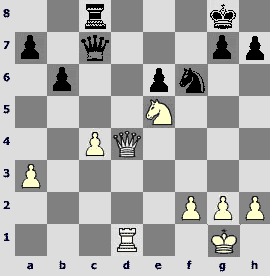
25.g4!±. The so-called move "without rhyme or reason", without any obvious attack on the queenside creates a great impression. Its logic seems to be quite clear, when it has been already made – Black cannot launch on a resistance to the white king – his pieces are too passive – but it would be extremely useful to bring them up and to endanger g5 for the future. 25.Јd6 Јxd6 26.¦xd6 ¤e4 (26...b5? 27.¤c6ќ) 27.¦d4І.
25...h6 26.h4 Јc5 27.g5 hxg5 28.hxg5 Јxd4 29.¦xd4±. In the endgame White has a considerable positional advantage, almost a domination.
29...¤h5 30.ўg2 ўh7 31.f4 ¦f8 32.ўf3 ¦f5 33.¤d3 g6 34.¦d7+ ўg8 35.ўg4 ¦a5 36.¤e5 ¦xa3 37.¤xg6 ¤g7 38.¦d8+ ўf7 39.¤e5+ ўe7 40.¤c6+ ўf7 41.¦d7+ ўf8 42.g6 ¤e8 43.¦f7+ 1–0. I do not know how does the reader feel, but the 21st and 25th moves made a strong impression on me (and even not only on me).
An avoidance of placing a rook on an open file is a quite common case of standard maneuver disturbance.
Karpov (2705) – Kasparov (2715) D55
Moscow (m/27) 1984
1.¤f3 d5 2.d4 ¤f6 3.c4 e6 4.¤c3 Ґe7 5.Ґg5 h6 6.Ґxf6 Ґxf6 7.e3 0–0 8.Јc2 c5 9.dxc5 dxc4 10.Ґxc4 Јa5 11.0–0 Ґxc3 12.Јxc3 Јxc3 13.bxc3 ¤d7 14.c6 bxc6 15.¦ab1 ¤b6 16.Ґe2 c5
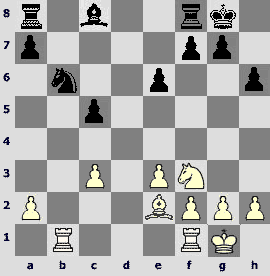
17.¦fc1 (!) As many other decisions of Karpov, this move itself in isolation from the game is not bad, but nothing more. About 15 draws that were made after this game in 1984-2000 are the best evidence of it. However, it is perfect as a player's decision exactly in this game! I remind you that at the moment of the 27th encounter of the unlimited match the score was already 4 : 0 in favor of Karpov, and the opponents were making draws by mutual consent during more than ten games. This time one did not manage to make a draw. 17.¦fd1 Ґb7 and ¦fd8 does not work for White.
17...Ґb7. A development of the rook on d1 would prevent from the move Ґd7 because of ¦xb6, and Kasparov acts in the same way as in case of ¦fd1 – he brings over the bishop on b7 that very unexpectedly leads to the difficulties. As White does not fight for the d-file in case of the text move and tries to play with both rooks on the queenside, 17...Ґd7 would be better to control the squares b5 and a4.
18.ўf1 Ґd5. Perhaps one should better have put the bishop on the diagonal a4-e8: 18...Ґc6 19.¤e5 Ґa4 20.Ґb5 Ґxb5+ 21.¦xb5 ¦fc8 22.¤d3 c4 23.¤b2ІE.Geller.
19.¦b5 ¤d7 (19...Ґxa2 20.c4ќ; better is 19...¦ac8 20.¦a5 ¦c7 21.c4 Ґa8 (M.Taimanov, Y.Averbakh) – all these variations are not fatal for Black. 20.¦a5 ¦fb8 21.c4 Ґc6 22.¤e1 ¦b4
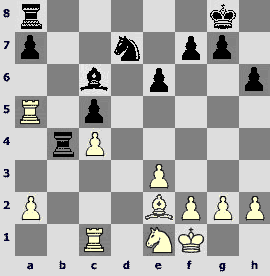
23.Ґd1! prevents a rook exchange, whereupon the c5-pawn stays unprotected.
23...¦b7. 23...Ґe4 24.Ґa4 (24.f3 ¦b1 25.¦xb1 Ґxb1 26.e4 f5) 24...¤e5 25.Ґb3 ¤d7 26.¦d1 ¦b7 27.f3 Ґg6 28.Ґa4± also cannot save the pawn.
24.f3 ¦d8 25.¤d3 g5 26.Ґb3 ўf8 27.¤xc5 ¤xc5 28.¦xc5±, and White has surmounted the opponent's resistance and realized the extra pawn.
Ivanchuk (2710) – Kasparov (2830)
Rethimno 2003

20...¦fc8!? avoiding a symmetrical 20...¦fd8, Kasparov allows his opponent to seize the d-file and even to attack the h6-pawn. One can only guess what was the reason for not brining the rook on d8. Perhaps, an unwillingness to exchange all the rooks? Display of Black's resources? A prophylaxis against the idea ўc2 and b4 with gradual strengthening of White's position?
21.ўb1 f5 22.¦d4 ¤b3 23.¦d3 ¤c5 24.¦d4 ¤b3 25.¦h4. If Black wants to win, he has only to assault on h6 and to play g2-g4 at the right moment. He has no other plans.
25...ўg7 26.ўa2 ¤c5 27.¦d1 a6 (27...¦d8?! 28.¦hd4) 28.¦hd4 b5
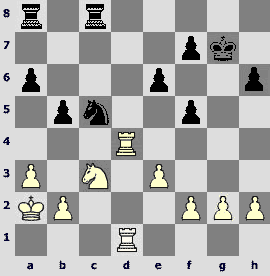
29.g4! (29.b4 ¤e4 30.¤xe4 fxe4 31.ўb2 f5=) 29...fxg4 (29...e5?! 30.¦d5 fxg4 31.¦xe5І) 30.¦xg4+ ўf8 31.¦h4 ўe7!
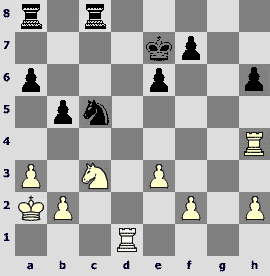
It turns out that Black can lose a pawn for the d-file that he did not want to occupy.
32.¦dd4 (32.¦xh6 ¦d8 33.¦h4 ¦xd1 34.¤xd1 ¦d8 35.¦d4 ¦h8 36.h4 e5 37.¦d5 ¤d7=) 32...¦g8 33.¦xh6 (33.b4 ¤b7!? 34.¦xh6 ¤d6 35.¦h5 ¦g2©) 33...¦g2. For Black this counterplay is enough to make a draw.
34.f4 ¦d8 35.f5 (35.¦xd8 ўxd8 36.f5 ¤d3=) 35...¦xd4 36.exd4 ¤d3 37.fxe6 fxe6 38.d5 ¦xb2+ 39.ўa1 exd5 40.¤xd5+ ўd7 41.¤f4 ¦d2 42.¤xd3 Ѕ–Ѕ
Finally, some of the patterns deal with general strategic principles rather than with definite positions.
Indeed, all these principles are extremely relative, and they were changed almost to the contrary ones, for example in time of hypermodernism, more than once.
For example, one thinks that it is not advantageous for White to release the tension in the centre for free, and Black has to counterattack the centre of the opponent (in a closed position), because when the activity is carried out on the queenside, White is let loose on the kingside.
Navara (2620) – Korchnoi (2601) C05
Calvia (Olympiad) 2004
1.e4 e6 2.d4 d5 3.¤d2 c5 4.¤gf3 ¤f6 5.e5 ¤fd7 6.c3 ¤c6 7.Ґd3 a5!? It is a standard continuation – 7...Јb6 (an attack of the centre!) 8.0–0!? cxd4 9.cxd4 ¤xd4 10.¤xd4 Јxd4 – White receives a good compensation for a pawn.
8.0–0 Ґe7 9.¦e1 c4!? 10.Ґc2 b5 11.¤f1 ¤b6 12.¤3d2 h5 13.f4 b4 14.Јf3 g6 15.g3 a4 16.a3 bxa3 17.bxa3 ¤a5 18.h3 ¤b3 19.¦a2 ¦b8 20.g4
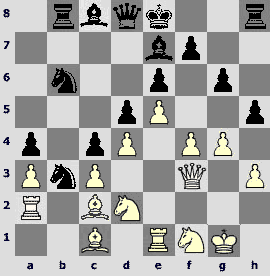
The fact that White has to play f4-f5 forces him to open his king and give counterchances to his opponent.
20...hxg4 21.hxg4 ¤a8 22.¤b1 (22.f5 gxf5 23.gxf5 ¦g8+ 24.ўh1 Ґxa3! and Јh4+ Korchnoi) 22...¤c7 23.¤g3 ¤b5 24.Ґe3 (24.f5 gxf5 25.gxf5 Ґh4) 24...ўd7? (24...Ґh4 still does not allow f4-f5. The evaluation of the position is not quite clear in this case.) 25.f5 gxf5 26.gxf5 Ґh4 27.f6
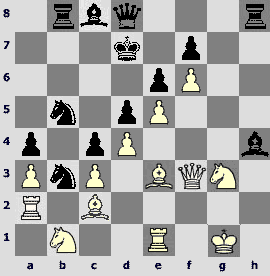
27...¦g8? (27...Ґxg3 28.Јxg3 ¦g8 29.Ґg5 Јa5 (Korchnoi) with a counterplay on the queenside) 28.Ґf4 ўc6 29.ўg2 ¦h8 30.¦h1 Јg8? (30...Ґxg3) 31.¦h3 Ґd7 32.Ґe3 ўc7 33.Јf4 Ґxg3 34.¦xg3 Јf8 35.¦g7 ўb6 36.Ґd1 ўa6 37.Јg5 Ґe8 38.Ґc2 Ґc6 39.Ґh7 ¤c7 40.Јh5 Ґe8 41.¦b2 ¤b5 42.Ґh6 ¤xa3 43.¦g5 ¦xh7 44.Ґxf8 ¦xh5 45.¦xh5 ¤b5
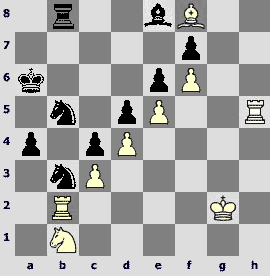
46.Ґd6? (46.Ґe7ќ; 46.¦a2ќ) 46...¤xd6 47.exd6 ўb5 48.¦h8 ўc6 49.¦a2 ¦a8 50.¤a3 ўxd6 51.ўf3 ¤c1 52.¦b2 ўc7 53.¦g2 ¦b8 54.¦gg8 ўd7 55.¦f8 ¦d8 56.ўe3? (56.¤b5 ¤d3 57.¤c7 ўxc7 58.¦xe8 ¦xe8 59.¦xe8ќ ўd6 60.¦a8 e5 61.¦a6+ ўc7 62.dxe5 ¤xe5+ 63.ўe3 ўb7 64.¦xa4 ¤g4+ 65.ўd4 ¤xf6 66.¦a3 ўb6 67.ўe5ќ) 56...¤d3 57.¤b5 e5! 58.¤d6 exd4+ 59.ўxd4 ўxd6 60.¦xe8 ¦xe8 61.¦xe8 ¤f4 62.¦e7 a3 63.¦xf7 ¤e6+ 64.ўe3 ўe5 65.¦a7 ўxf6 66.¦xa3 ўe5 67.¦a7 ¤g5 68.¦e7+ ¤e6 69.¦h7 ўd6 70.¦h5 ўc6 71.¦h1 ўd6 72.¦e1 ўe5 73.ўf3+ ўf5 74.¦d1 ўe5 75.¦e1+ ўf5 76.¦h1 d4 77.cxd4 ¤xd4+ Ѕ–Ѕ
What kind of conclusions that are useful in practice can we draw out of aforesaid?
First of all, an ability to find positionally non-standard moves (one does it quickly and naturally, because it is very important for calculation – one has to determine candidate moves not only at the first move of the variation) distinguishes the greatest players and is one of the factors of their success.
Secondly, an improvement in "vision" of positionally non-standard moves is quite possible – it is not a purely an innate quality. There are a lot of methods to develop it.
It is very useful to analyze your own games, to support the evaluations with variations, the longer they are, the better (the evaluations can turn out to be wrong, but the variations, especially when they are tested by computer, are nearly the truth in the last instance). Probably, the main point here is to catch the general incorrect arrangements and evaluations behind the concrete blunders.
A selection of similar examples from the grandmaster practice that are unified by the commonness of broken pattern is extremely reasonable.
Finally, one has to try, at least at home, a well-known method of "brainstorm" – at the initial stage you can have a look at the wide range of opportunities and only then process them critically.
The author used the annotations to the games of Korchnoi, Kramnik, Finkel, Ftacnik, Postny and Krasenkow.
